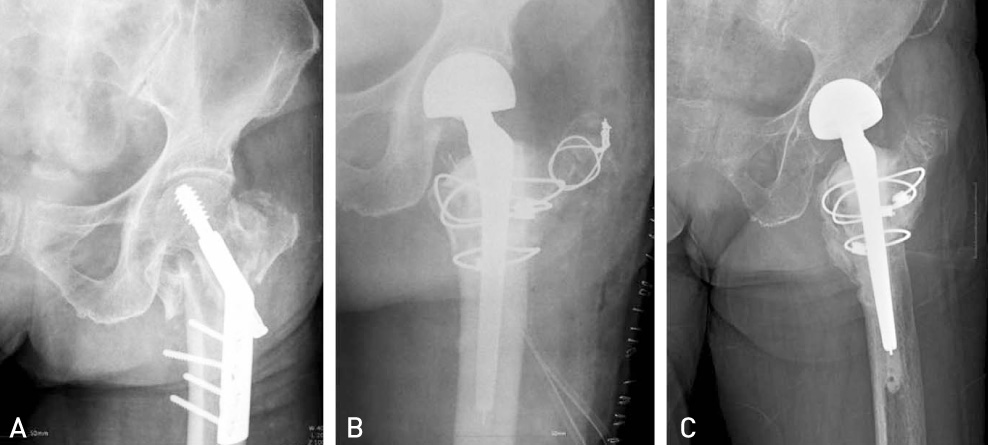Hip Pelvis.
2012 Jun;24(2):94-101. 10.5371/hp.2012.24.2.94.
Hip Arthroplasty for Failed Internal Fixation of Intertrochanteric Fractures
- Affiliations
-
- 1Department of Orthopedic Surgery, Gwang-ju Veterans Hospital, Gwangju, Korea. chm1228@hanmail.net
- KMID: 1439097
- DOI: http://doi.org/10.5371/hp.2012.24.2.94
Abstract
- PURPOSE
To analyze the clinical and radiological results of hip arthroplasty following the failed internal fixation of intertrochanteric fractures of the femur.
MATERIALS AND METHODS
We analyzed the reasons for failure in 29 cases of hip arthroplasty from January 1997 through December 2008 in which the hip arthroplasty was necessary due to failed internal fixation of an intertrochanteric fracture of the femur. Furthermore, we tried to find pitfalls encountered when performing the operations. We assessed those patients and drew both clinical (Harris hip score, HHS) and radiological results. The follow-up period was 34.2 months(12-96 months), on average.
RESULTS
The average operating time was 174 min.(115-205 min.) and the mean amount of perioperative bleeding was 1,335 ml(759-2,450 ml). The amount of packed RBC transfusion was 2.8 units(0-10 units) on average. We could see prolonged operation time and a large amount of blood loss as we performed both the removal of the previously fixed implant and reduction of the displaced bone fragment simultaneously. The mean Harris hip score of the patients was improved from the preoperative score of 43 to the postoperative score of 85.7. No cases showed any radiological signs of loosening of acetabular cups or femoral stems, although an articular dislocation and a postoperative joint infection occurred.
CONCLUSION
Although hip arthroplasties performed because of a failure in internal fixation could provide relatively satisfactory outcomes, as they result in extended surgery time and greater blood loss, a requirement for higher-level surgical skills, and greater consideration required for the systemic conditions of patients before performing surgery.
Figure
Cited by 1 articles
-
Bipolar Hemiarthroplasty Using Calcar Replacement Stem for Unstable Intertrochanteric Femoral Fracture in Elderly Patients
Dukhwan Kho, Kyoungmo Nam, Daemyung Kang, Hyeungjune Kim
Hip Pelvis. 2013;25(3):203-210. doi: 10.5371/hp.2013.25.3.203.
Reference
-
1. Aune AK, Ekeland A, Odegaard B, Grøgaard B, Alho A. Gamma nail vs compression screw for trochanteric femoral fiactures. 15 reoperations in a prospective, randomized study of 378 patients. Acta Orthop Scand. 1994. 65:127–130.
Article2. Park MS, Lim YJ, Kim YS, Kim KH, Cho HM. Treatment of the proximal femoral fractures with proximal femoral nail antirotation (PFNA). J Korea Fract Soc. 2009. 22:91–97.
Article3. Babst R, Renner N, Biedermann M, et al. Clinical results using the trochanter stabilizing plate (TSP): the modular extension of the dynamic hip screw (DHS) for internal fixation of selected unstable intertrochanteric fractures. J Orthop Trauma. 1998. 12:392–399.
Article4. Bonamo JJ, Accettola AB. Treatment of intertochanteric fractures with a sliding nail-plate. J Trauma. 1982. 22:205–215.5. Adams CI, Robinson CM, Court-Brown CM, McQueen MM. Prospective randomized controlled trial of an intramedullary nail versus dynamic screw and plate for intertrochanteric fractures of the femur. J Orthop Trauma. 2001. 15:394–400.
Article6. Albareda J, Laderiga A, Palanca D, Paniagua L, Seral F. Complications and technical problems with the gamma nail. Int Orthop. 1996. 20:47–50.
Article7. Simmermacher RK, Bosch AM, Van der Werken C. The AO/ASIF-proximal femoral nail (PFN): a new device for the treatment of unstable proximal femoral fractures. Injury. 1999. 30:327–332.
Article8. Fracture and dislocation compendium. Orthopedic Trauma Association Committee for Coding and Classification. J Orthop Trauma. 1996. 10:Suppl 1. v–ix. 1–154.9. Harris WH. Traumatic arthritis of the hip after dislocation and acetabular fractures: treatment by mold arthroplasty: An end-result study using a new method of result evaluation. J Bone Joint Surg Am. 1969. 51:737–755.
Article10. Engh CA, Bobyn JD, Glassman AH. Porous-coated hip replacement. The factors governing bone ingrowth, stress shielding, and clinical results. J Bone Joint Surg Br. 1987. 69:45–55.
Article11. Barrack RL, Mulroy RD Jr, Harris WH. Improved cementing techniques 307 and femoral component loosening in young patients with hip arthroplasty. A 12-year radiographic review. J Bone Joint Surg Br. 1992. 74:385–389.12. Bong SC, Lau HK, Leong JC, Fang D, Lau MT. The treatment of unstable intertrochanteric fractures of the hip: a prospective trial of 150 cases. Injury. 1981. 13:139–146.
Article13. Said GZ, Farouk O, El-Sayed A, Said HG. Salvage of failed dynamic hip screw fixation of intertrochanteric fracutres. Injury. 2006. 37:194–202.
Article14. Haidukewych GJ, Berry DJ. Hip arthroplasty for salvage of failed treament of intertrochanteric hip fractures. J Bone Joint Surg Am. 2003. 85-A:899–904.15. Hesse B, Gächter A. Complications following the treatment of trochanteric fractures with the gamma nail. Arch Orthop Trauma Surg. 2004. 124:692–698.
Article16. Patterson BM, Salvati EA, Huo MH. Total hip arthroplasty for complications of intertrochanteric fracture. A technical note. J Bone Joint Surg Am. 1990. 72:776–777.
Article17. Edgerton BC, An KN, Morrey BF. Torsional strength reduction due to cortical defects in bone. J Orthop Res. 1990. 8:851–855.
Article18. Zhang B, Chiu KY, Wang M. Hip arthroplasty for failed internal fixation of intertrochanteric fractures. J Arthroplasty. 2004. 19:329–333.
Article
- Full Text Links
- Actions
-
Cited
- CITED
-
- Close
- Share
- Similar articles
-
- Blade Plate Fixation for Failed Internal Fixation of Intertrochanteric Hip fractures
- Cement Filling Technique to Prevent Greater Trochanter Displacement in Hip Arthroplasty for Femoral Intertrochanteric Fracture: A Technical Note
- Treatment of Failed Internal Fixation of Intertrochanteric Fractures of Femur
- Analysis of the Causes for Failed Compression Hip Screws in Femoral Intertrochanteric Fracture and Hip Reconstruction Operation
- Analysis and Management of Failed Intertrochanteric Fracture Fixation




